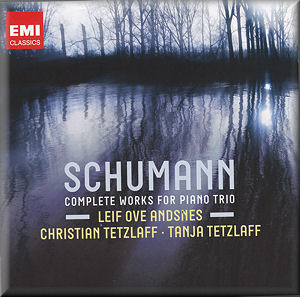 |
 |
|


alternatively
CD: MDT
AmazonUK
AmazonUS
|
Robert SCHUMANN (1810-1856)
Complete Works for Piano Trio
Piano Trio No. 1 in D minor, Op. 63 (1847) [31:16]
Piano Trio No. 2 in F major, Op. 80 (1847) [25:47]
Six ╔tudes in Canonic Form, Op. 56 (arr. Theodor Kirchner)
(1845) [17:58]
Piano Trio No. 3 in G major, Op. 110 (1851) [28:06]
FantasiestŘcke for piano, violin and cello, Op.88
(1842) [18:26]
 Leif Ove Andsnes (piano); Christian Tetzlaff (violin); Tanja Tetzlaff
(cello)
Leif Ove Andsnes (piano); Christian Tetzlaff (violin); Tanja Tetzlaff
(cello)
rec. 24-26 September 2009, 15-18 May 2010, ěstre Fredrikstad Kirke,
Gamlebyen, Fredrikstad, Norway
 EMI CLASSICS 0941802 [75:15 + 46:41]
EMI CLASSICS 0941802 [75:15 + 46:41] 
|
|
|
This double CD set of Schumann’s Complete Works for Piano
Trio is a welcome addition to the chamber music catalogue.
The trio prove to be fine ensemble giving both stirring and
satisfying performances. There is a something very natural about
the musicianship on show here.
Schumann’s works for Piano Trio were greatly inspired by the
chamber works of Haydn, Mozart, Beethoven, Mendelssohn and Schubert
- all great masters that he passionately revered. Composed in
1842 the little suite of Four Character Pieces was Schumann’s
earliest work in the genre. He later revised it for publication
in 1850 as his FantasiestŘcke, Op. 88. It is an appealing
and rewarding score, light and melodic in texture. The first
piece is the shortest - a tender yet rather serious Romanze.
A far lengthier piece, the Humoreske is light-hearted
and buoyant with a touch of seriousness. Like a gentle dialogue
the violin and cello play a delicate Duet over sensitive
piano accompaniment. I enjoyed the joyous reverie and march-like
rhythms of the Finale.
For a library version of the Fantasiestucke I can enthusiastically
propose the 2002 Berlin account from Martha Argerich, Gidon
Kremer and Mischa Maisky. The starry cast performs with spontaneity,
swiftness and great zeal on Deutsche Grammophon 463 700-2. (c/w
Brahms Piano Quartet No. 1, Op. 25 with Yuri Bashmet,
viola)
In 1845 Schumann composed his Six ╔tudes (Studies)
in the Form of Canons for Organ or Pedal Piano, Op. 56.
Schumann’s friend Theodor Kirchner later arranged these for
piano trio. Light, varied and enjoyable pieces the breezy first
is quite lovely. ╔tude two is tender, a touch demure
and the contrasting third is melodic and expressive with
a distinct sighing quality. The fourth is a charming
romantic song, the highly rhythmic fifth piece is dance-like
followed by the sixth, a heart-breaking elegy
heavy with loneliness.
Schumann composed his four movement Piano Trio No. 1
in 1847. He gave his wife Clara the score as a present for her
twenty-eighth birthday. This is the longest, most symphonic
and most reflective in character. It is regarded by many as
the greatest of the three. Clara recorded in her diary that,
“The first movement is one of the most beautiful that I know.”
The appealing opening feels symphonic in texture with a windswept
and restless ambience. The Scherzo swells with forward
momentum. Its relatively calm centre soon gives way to the return
of the surging writing. Like an extended lament the third movement
exudes a deeply aching melancholy. The boldly resolute Finale
is more positive and ebullient.
It was typical of Schumann to follow one successful work with
another in the same genre. He began preliminary work on his
four movement Piano Trio No. 2 before he had finished
the D minor, Op. 63. In her diary Clara noted, “I
love it passionately and keep on wanting to play it!” The
high-spirited opening evokes a sense of summer and open spaces.
The rapturous slow movement is highly appealing. Agreeable and
somewhat delicate the music feels rather too slow for a Scherzo
more in the manner of a Minuet. A breezy Finale
with a curious hesitancy increases in speed but is soon
reined back in.
Following the F major Piano Trio it was four years before
Schumann in 1851 wrote his four movement Piano Trio No. 3,
Op. 110. The amiable and high-spirited score made quite an impression
on Clara who commented that, “It is unique, full of passion,
through and through…” Schumann dedicated it to his friend
the composer Niels Gade. In the opening movement the highly
passionate, sweeping lines carry the burden of anxiety. Refined
and sensitive the second movement has a stormy central section
that rudely interrupts the mood before the gentle dance returns.
A curiously paced and agitated Scherzo contains swiftly
changing tempi and moods. The Finale overflows with joy
and uplifting bursts of energy, however a certain restlessness
is never far away.
For alternative accounts of Schumann’s three Piano Trios
I can recommend the exceptional set from the eminent Beaux Arts
Trio. Recorded in 1971 at La Chaux-de-Fonds in Switzerland the
polished trio play with remarkable liveliness and refinement.
Now over forty years old these evergreens belie their age with
the recording remaining extremely impressive (Philips 456 323-2
c/w Piano Quintet, Op. 44 and Piano Quartet, Op.
7).
The accompanying booklet contains a fine essay from David Threasher.
It is pleasing to have such fine accounts from the Andsnes-Tetzlaff
trio but they do not replace some of the more established versions.
Even so the music is closely recorded, warm with a well balanced
sound quality.
Michael Cookson
|
|

